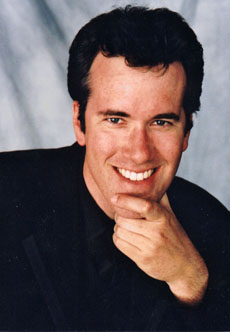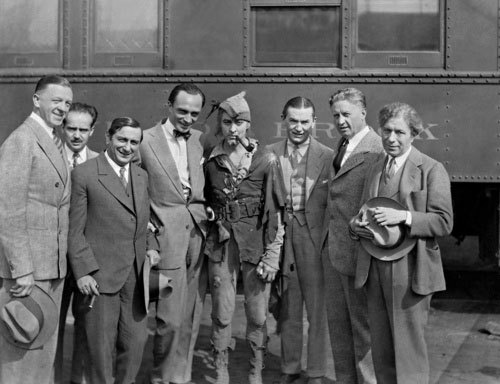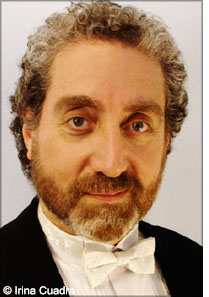Review: William Perry's Music for Great Films of the Silent Era – The Three Rhapsodies
The three "rhapsodies" on this CD are excerpts from their full soundtrack versions which accompanied the films when they appeared in the 1971 series The Silent Years, hosted by Orson Welles. (A collection of music from that 1971 series was first released on CD in 1995 on William Perry's The Beloved Rogue: Music of the Silent Years, through Premier Recordings.)
Home Page |
Newsletter, |
Explains William Perry about The Silent Years: Three Rhapsodies for Piano and Orchestra, “This can be played as a piano concerto, as you hear it on the Music for Great Films of the Silent Era CD, but it is really intended, and has always been done in recent performance, to be presented with projected film, abridgements of the actual silent films. And by the way, the synchronization of the film with live playing is a challenge that conductors seem to relish.”
Michael Chertock, chair of the piano department at the College-Conservatory of Music, University of Cincinnati, and who appeared as piano soloist in selections on both Music for Great Films of the Silent Era CDs, shares that "William Perry's music is a perfect reflection of his personality: irrepressibly enthusiastic, colorful, optimistic and lyrical. My first opportunity to play the piano parts of the rhapsodies for Bill was actually over the phone! Bill is a very generous spirit, and he made only a few small suggestions about tempi and phrasing.
"I learned a great deal about his music by listening to him talk about the formative events in his life which included not only a career on Madison Avenue, but years producing films and television shows, composing for Broadway and countless silent film scores. Bill is a wonderful storyteller and his music often has a narrative feel and his purely instrumental tunes often suggest lyrics and spoken language."

Michael Chertock, piano soloist performing on both Music for Great Films of the Silent Era CDs: William Perry's compositional style is very congruent with music from the golden age of Hollywood. He favors lush melodies, romantic harmonies and creative orchestral effects suggestive of silent movies. Bill cut his teeth as a musician by improvising at the piano accompanying silent films. Some of my favorite portions of The Gold Rush, starring Charlie Chaplin, are the scenes with clanking iron to suggest mining, and the music that suggests a raging blizzard.
THE BELOVED ROGUE (1927) video clip, featuring William Perry's 1971 piano score excerpt.
(Released on Republic Pictures VHS and laserdisc. Kino Lorber has in its catalogue the 98 minute version DVD that features Perry's 1971 full piano score: https://www.kinolorber.com/film/view/id/682)
Track 7: The Beloved Rogue (1927) With royal fanfare and a merry intro, John Barrymore enters as “the beloved rogue”– sometimes petty thief, womanizer and sot – as French poet Villon. His friend warns him to have “only one” drink, rather than a whole tankard of wine. The orchestra jubilantly celebrates Villon on All Fools' Day when he's elected the “King of Fools” by French King Louis XI, played by Conrad Veidt. But upon insulting the Duke of Burgundy (Lawson Butt), Villon is promptly exiled by the king who fears the duke, a rival seeking his throne.
After catapulting food into the streets for the poor, Villon escapes exile by being flung away by the same catapult – right through the window and into the boudoir of Marceline Day – and that's some high flying romance! She's slowly brought into camera focus with sheer shock upon her face, and doesn't realize that her intruder is the poet himself.
Strings and piano cue a building sense of amour as she unknowingly defends the poet to his face, proclaiming that such an immortal (a person of unsurpassed creative talent, no matter the medium), a genius, does not deserve to exist for the most part unrecognized as a drunken clown in the streets. Upon the couple being discovered, the romantic background music soars higher and prevails with reverberating cymbals as they flee, raucously dodging their pursuers and coasting down snowy rooftops into a little hovel where they declare their love for one another.
Villon is then pardoned after the king declares that the man's patriotic poetry has done more for France than a sword ever could have, and the lovers are radiant as they kiss to exultant horn fanfare. The last moment ties to the earlier scene in the film as the poet's friend again warns to have "only one" – and everyone will recognize the meaning of Villon's timeless jeering gesture in reply.

Conrad Veidt arrives in Hollywood in 1926 to play King Louis XI in The Beloved Rogue (1927), standing to the left of John Barrymore in costume as the French poet, François Villon. Left to right – Hans Kraley, Paul Bern behind Ernst Lubitsch, Conrad Veidt, Barrymore with pipe and in costume, John Considine, director Fred Niblo, and Sid Grauman.
As related by Wiki, “This film was lost for some 40 years until a beautiful tinted and toned copy was discovered in the late 1960s in the collection of film pioneer Mary Pickford.... This surviving Pickford print of The Beloved Rogue represents what a true tinted and toned silent film looks like, made directly on tinted film stock prevalent in the silent era.”
BLOOD AND SAND (1922) video clip, featuring William Perry's 1971 piano score excerpt. Link courtesy of William Perry. (Movie released on Republic Pictures VHS and laserdisc.)
Track 8: In Blood and Sand incidental music introduces a market square and translates into background music for the bloodthirsty escapade in the bullring. Rodolph (later known as Rudolph) Valentino as Juan, in his "suit of lights," conquers his quarry. The roles of bull and matador are musically suggestive in the cross-play, as the masculine bull charges at the teasing swing of the feminine cape that separates it from the equally powerful bullfighter. Horns and hooves are matched against swords and instinctive strategy.
The tension increases with the instrumentals throughout the man against beast battle, and then Juan the victor accepts his award with the string section cheering along with the ecstatic crowd. Prowess now proven in the ring, romance whispers promisingly. He takes the proceeds of his first successes and courts his sweetheart. An intertitle card swears his faithfulness to his betrothed. The wedding celebration over, he is later seen in a bario Flamenco dancing as the orchestra carouses along to the festive clack of castanets.
But soon, the glut and gloat of power begins to weave a corrupt, pernicious thread through his heart's soul. In the bullring he once made enough pesos to be able to afford a wife – now he would became the luxury toy of a woman seeking a new hobby. It doesn't take long before the storyline and the song sink into dark temptations of decadence and broken wills. Like many a well-intentioned hero, he publicly has a faithful wife – and a senorita on the sly. Juan the victorious bullfighter succumbs to the feminine wiles of Seville jewels and heavy velvet curtains in a luxurious sitting room. The labour and passion of piano keys intensifies during the scene as the emotions of the lovers soon rise into a heated argument and her mocking laughter.
Possibly the most moodily romantic and luscious track of the CD composed by Perry, the melody has the richness of exotic, scented Turkish cigarettes, the impression of flickering table candles, and the stamping foot beat of the matador/bolero dancer. The lavishness and the savagery of the scenes are all bolstered by the composition as it magnifies in strength and power. Then the music quietens, withdraws, as hesitant tension remounts in the brutal sport of his final bullring – along with his last chance to get the love right in his life. Will Juan succeed in regaining his honour and his true love's heart? All this is soon revealed. Juan had pledged the bull to Plumitas, a friend (but also a criminal) returned from his youth. The instrumentals merge desirous love with the desire to honour his friend Plumitas even as the man is arrested.
It is the bull that decides fatal judgement upon Juan. With the bull also dead, the score settles down into a pensive bridging theme, drawing the beginning and the middle of the song and story to a conclusion. Only true love won the day. While his former mistress powders her face unconcernedly, her brave bullfighter, in his honourable way out of the ring, also lost his battle with her. Only Juan's wife is with him. Last kisses and whispers speak of love and forgiveness as the orchestra resonates the theme more loudly about them. The music crescendos still more as the final title cards appear – "Poor matador – " and "- poor beast!" with the final proclamation, "But out there is the real beast – a beast with ten thousand heads!"
Above all, Perry's score, as performed by the orchestra and highlighted by Chertock's piano solo, resulted in an eloquent, poignant recording that is unequivocally representative of his unmatched skill in presenting a tenderly romantic composition. (For the Killiam-Republic Pictures restoration of Blood and Sand presented on PBS' The Silent Years in 1971, William Perry momentously performed his score playing upon composer Sergei Rachmaninov's own piano.)
THE GOLD RUSH (1925) video clip,featuring William Perry's 1970 piano score excerpt. Link courtesy of William Perry. (Movie released on Republic Pictures VHS and laserdisc.)
Track 9: The Gold Rush sees, as with the forge into new territory once made by pioneers – with musical echoes of settling that once new land farther south – fortune hunters likewise joining the Klondike Goldrush of 1897. Braving the unknowns of a frosty northern frontier, it's a lonelier journey for these gold seekers by foot, travelling in a seemingly endless single line rather than in a herd of covered wagons. Each man wants to protect his claim, especially if it turns out be a motherlode. As the long line of prospectors climb a mountain pass, the orchestra strikes with an anvil suggesting the pick axe work to come. Reaching claim sites was difficult, and picking for gold would be even more of a struggle; some men would not even survive the climb.
Early on, broken away from the bunch, star Charlie Chaplin is always one step ahead of calamity and builds the comedy to a breezy melody. He hikes a mountain pass while unknowingly being followed by a bear! Then, abruptly, success! Albeit for another gold hunter. A "lucky strike" and "A mountain of Gold!" proclaim the intertitle cards – solitary prospector, Jim, has struck it reasonably rich. The orchestra celebrates right along.
Then, the piano and orchestra sombre down into tragic tones in apprehension of a storm almost on the doorstep. Swirling minor chords augment fierce winds churning through the mostly barren landscape, battering the little prospector cabin in which both Chaplin and Jim have taken refuge. The orchestra lilts sweetly as the hungry men wait on the boot "cooking" in the fireplace soup kettle; the music continues blithely as dinner is served.
Following the storm, Charlie travels to a northern town and stops in at a dance hall. The melody is chipper, with adventurous long bow strokes and marimba-like percussion tapping. The romantic piano brings promise of a new love into his life, Georgia, and the full orchestra celebrates his inviting her and her girlfriends to New Years Eve dinner at the cabin.
The evening arrives soon enough, but Georgia and her friends do not. He goes on to imagine the evening, a large party held in a hall; in the daydream the hall clock strikes midnight with a bell gong from the orchestra. He dreams on, pretending the girls have joined him at the cabin. Then starts a joyous music box-like upper note celesta sequence, to accompany the famous "dinner roll" scene. Quickly this happy froth turns into even greater jubilation when back at the claim, Jim finds the prize, enough gold he tells Charlie that will make them both millionaires. So, they travel on an ocean liner in new finery, furs, and fame. From rags to riches, from stewed boots to shaved beaver coats and top hats. While still aboard the vessel, Charlie encounters the woman from the Far North, and romantic strings garnish their renewed bliss.
As related by conductor Paul Phillips about how he came to be involved with silent film and their scores composed by William Perry:
 “The Silent Years television series brought us into contact with each other. Back in the early 1970s, Bill produced a show on PBS called The Silent Years, which presented many great silent films with original scores that he composed and played on the piano. I fell in love with those old films, and their scores, and bought a recording of Perry playing the Silent Years music that I listened to many times.
“The Silent Years television series brought us into contact with each other. Back in the early 1970s, Bill produced a show on PBS called The Silent Years, which presented many great silent films with original scores that he composed and played on the piano. I fell in love with those old films, and their scores, and bought a recording of Perry playing the Silent Years music that I listened to many times.
“Thirty years later, wondering if the Silent Years music had ever been orchestrated, I looked up William Perry on the Internet and contacted him to ask. This was around 2007. He told me that he was then in the process of converting many of his silent film scores into orchestral compositions, and that he planned to convert some of the Silent Years music into a suite for solo piano and orchestra, but that first he had composed a piece called Six Title Themes in Search of a Movie and was looking for an orchestra to premiere it. I jumped at the chance, which led next to the Gemini Concerto, and then to this recording.
“It was a thrill to record The Silent Years: Three Rhapsodies for Piano and Orchestra, which had not yet been performed live when we recorded it in 2010. Michael Chertock, a phenomenal pianist, played brilliantly on the recording, perfectly capturing the elan and poignancy of Perry’s style. Once we finished the recording, I asked Michael if he would come to Brown University to perform it in concert. He readily agreed and that fall we premiered the music as The Silent Years at Brown University in October 2010.
“For those performances, I asked Bill Perry what he thought of the idea of creating shortened versions of The Beloved Rogue, Blood and Sand, and The Gold Rush – the three films represented in The Silent Years – to be shown while we played the music. Bill was skeptical that it could be done in a way that would match the screen images to the character of each different section of music, but agreed to let me proceed with the plan.
“I had a particular editor in mind –my daughter Joanna, a budding film editor who was then an undergraduate at Columbia. The edited versions that she produced matched the film to the music so perfectly that Bill was amazed and delighted by the result.
“For the premiere of The Silent Years highlighting William Perry's shortened version of his rhapsodies, we projected the edited films while the piano soloist and orchestra performed in the dark (with stand lights), and received tumultuous responses from the sold-out audiences at both performances. The Silent Years has now been performed that way with film by a number of different orchestras, and always receives a great response from the audience.”